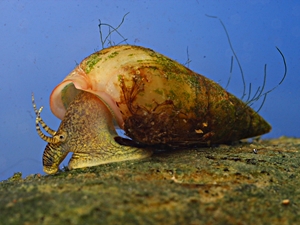 Esperiana daudebartii daudebartii, Melanopsidae. Picture: © Alexander Mrkvicka, Vienna (mrkvicka.at). |
The modern biological systematics is based on the conditions of evolutionary descent and not on mere external similarities between groups.
So today species and higher taxa are placed together in groups, because they can be proved to have descended from common ancestors. Next to morphological characters today it is more and more conclusions from molecular biology, making possible an ever clearer distinction of degrees of relation between single groups.
Systematic groups are called taxa (sg.: taxon), which is why giving scientific names to taxa in biology is called taxonomy.
Monophyletic taxa generally can be referred to as clades, no matter what their status is according to the common systematics.
The systematics of snails and slugs (Gastropoda) today still mostly is presented in the form of an obsolete system according to J. Thiele (1929 - 1931), dividing the class of Gastropoda into three subclasses, Prosobranchia or Streptoneura with their gills in front and crossed main nerves, Opisthobranchia with their gills to the rear and Pulmonata with lungs, the latter two joined as Euthyneura with parallel main nerves.
This division is not completely incorrect, but not sufficient for a scientific system. This is connected to the fact that the discovery of several new groups near hot vents on the ocean floor made necessary a complete revision of the system. Some groups of the Prosobranchia were revealed to be more closely related to Opisthobranchia than to other Prosobranchia. The consequence is that the Prosobranchia have to be regarded as a paraphyletic group, which may not be used in a biological system.
The system of Gastropoda according to Bouchet, Rocroi et al. (2005) here first is displayed in a concise form. In the detailed version, the sub-groups can be accessed down to the family level. Links lead on to those groups described more elaborately on the present homepage.